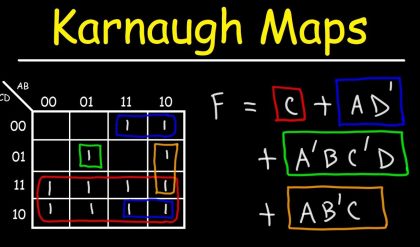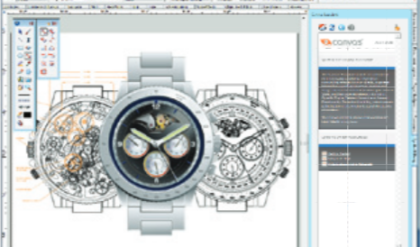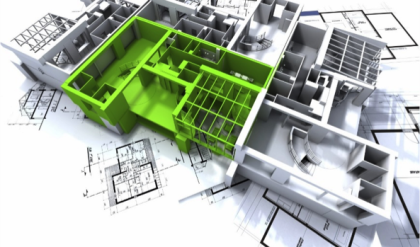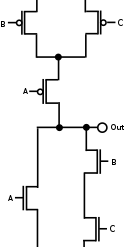Starting around the mid 1960s, with the IBM Drafting System, computer-aided design systems began to provide more capability than just an ability to reproduce manual drafting with electronic drafting, the cost-benefit for companies to switch to CAD became apparent. The benefits of CAD systems over manual drafting are the capabilities one often takes for granted from computer systems today; automated generation of Bill of Material, auto layout in integrated circuits, interference checking, and many others. Eventually, CAD provided the designer with the ability to perform engineering calculations. During this transition, calculations were still performed either by hand or by those individuals who could run computer programs. CAD was a revolutionary change in the engineering industry, where draftsmen, designers and engineering roles begin to merge. It did not eliminate departments, as much as it merged departments and empowered draftsman, designers and engineers. CAD is an example of the pervasive effect computers were beginning to have on industry. Current computer-aided design software packages range from 2D vector-based drafting systems to 3D solid and surface modelers. Modern CAD packages can also frequently allow rotations in three dimensions, allowing viewing of a designed object from any desired angle, even from the inside looking out. Some CAD software is capable of dynamic mathematical modeling. CAD technology is used in the design of tools and machinery and in the drafting and design of all types of buildings, from small residential types (houses) to the largest commercial and industrial structures (hospitals and factories).[8]
CAD is mainly used for detailed engineering of 3D models or 2D drawings of physical components, but it is also used throughout the engineering process from conceptual design and layout of products, through strength and dynamic analysis of assemblies to definition of manufacturing methods of components. It can also be used to design objects such as jewelry, furniture, appliances, etc. Furthermore, many CAD applications now offer advanced rendering and animation capabilities so engineers can better visualize their product designs. 4D BIM is a type of virtual construction engineering simulation incorporating time or schedule related information for project management.
CAD has become an especially important technology within the scope of computer-aided technologies, with benefits such as lower product development costs and a greatly shortened design cycle. CAD enables designers to layout and develop work on screen, print it out and save it for future editing, saving time on their drawings.
Uses
Computer-aided design is one of the many tools used by engineers and designers and is used in many ways depending on the profession of the user and the type of software in question. CAD is one part of the whole Digital Product Development (DPD) activity within the Product Lifecycle Management (PLM) processes, and as such is used together with other tools, which are either integrated modules or stand-alone products, such as:
· Computer-aided engineering (CAE) and Finite element analysis (FEA)
· Computer-aided manufacturing (CAM) including instructions to Computer Numerical Control (CNC) machines
· Photorealistic rendering and Motion Simulation.
· Document management and revision control using Product Data Management (PDM).
CAD is also used for the accurate creation of photo simulations that are often required in the preparation of Environmental Impact Reports, in which computer-aided designs of intended buildings are superimposed into photographs of existing environments to represent what that locale will be like, where the proposed facilities are allowed to be built. Potential blockage of view corridors and shadow studies are also frequently analyzed through the use of CAD. CAD has been proven to be useful to engineers as well. Using four properties which are history, features, parameterization, and high-level constraints. The construction history can be used to look back into the model’s personal features and work on the single area rather than the whole model. Parameters and constraints can be used to determine the size, shape, and other properties of the different modeling elements. The features in the CAD system can be used for the variety of tools for measurement such as tensile strength, yield strength, electrical or electromagnetic properties. Also its stress, strain, timing or how the element gets affected in certain temperatures, etc.
Types
here are several different types of CAD,[9] each requiring the operator to think differently about how to use them and design their virtual components in a different manner for each. There are many producers of the lower-end 2D systems, including a number of free and open source programs. These provide an approach to the drawing process without all the fuss over scale and placement on the drawing sheet that accompanied hand drafting since these can be adjusted as required during the creation of the final draft. 3D wireframe is basically an extension of 2D drafting (not often used today). Each line has to be manually inserted into the drawing. The final product has no mass properties associated with it and cannot have features directly added to it, such as holes. The operator approaches these in a similar fashion to the 2D systems, although many 3D systems allow using the wireframe model to make the final engineering drawing views.
3D “dumb” solids are created in a way analogous to manipulations of real-world objects (not often used today). Basic three-dimensional geometric forms (prisms, cylinders, spheres, and so on) have solid volumes added or subtracted from them as if assembling or cutting real-world objects. Two-dimensional projected views can easily be generated from the models. Basic 3D solids don’t usually include tools to easily allow motion of components, set limits to their motion, or identify interference between components.
There are two types of 3D Solid Modeling
1. Parametric modeling allows the operator to use what is referred to as “design intent”. The objects and features created are modifiable. Any future modifications can be made by changing how the original part was created. If a feature was intended to be located from the center of the part, the operator should locate it from the center of the model. The feature could be located using any geometric object already available in the part, but this random placement would defeat the design intent. If the operator designs the part as it functions the parametric modeler is able to make changes to the part while maintaining geometric and functional relationships.
2. Direct or Explicit modeling provide the ability to edit geometry without a history tree. With direct modeling, once a sketch is used to create geometry the sketch is incorporated into the new geometry and the designer just modifies the geometry without needing the original sketch. As with parametric modeling, direct modeling has the ability to include relationships between selected geometry (e.g., tangency, concentricity).





